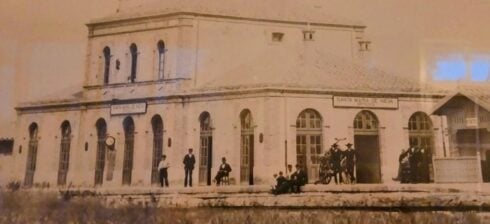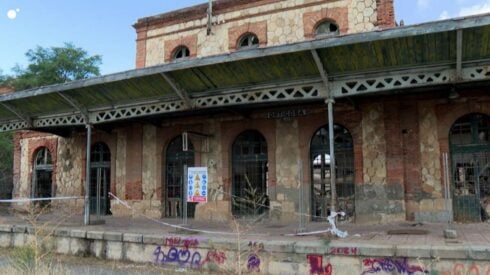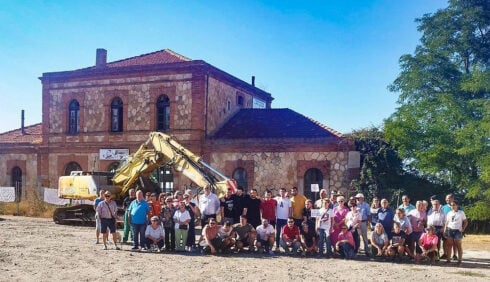SPAIN’S state rail operator is facing growing outrage after a wave of demolitions wiped out some of Catalonia’s oldest train stations.
Campaigners are warning that Adif is carrying out the destruction of historic buildings in silence and often ‘under cover of night.’
Heritage campaigner Daniel Pedrero Rosón raised the alarm over the threat to the last remaining freight station of La Sagrera in Barcelona, built in 1918, which is scheduled to be torn down next year.
READ MORE: Alicante stretch of road retains top position for most accidents and victims in Spain


It is the final survivor of the complex that once handled the city’s industrial transport links. Adif is reportedly taking advantage of the fact it lacks any formal heritage protection.
Pedrero accused both Adif and accompanying town halls of ‘ignorance and apathy’ for refusing to grant protection status to historic rail buildings, allowing them to disappear without public debate.

Among the demolished sites is the Ala de Correos at Barcelona’s Estació de França, a 1929 building razed in 2022 to make way for the new State Public Library.
In Sant Feliu de Llobregat, one of Spain’s oldest stations – dating from 1854 – was bulldozed on January 10, 2024, to build an underground replacement.
In Ávila, the 1864 Mingorría station was flattened on February 7, 2024, ‘ in the middle of the night’ after years of disuse, according to Pedrero.
READ MORE: Inside the castle village of Cadiz and the butterfly trail beneath Spain’s southern jungle

The Salou station in Tarragona, opened in 1865, was demolished in July 2024 to ‘eliminate the barrier effect’ of the old tracks, while Parets del Vallès station (1886) fell in September 2025 during the duplication of the R3 commuter line.
Only one site, Ortigosa de Pestaño station in Segovia, has so far escaped the wrecking ball thanks to local protests that forced Adif to suspend demolition.

But the council’s declaration of the building as ‘in ruins’ still stands, meaning its future remains uncertain.
Pedrero warned the pattern shows ‘a systematic erasure’ of Spain’s railway heritage and said the only thing delaying the total loss of 19th and early 20th century stations is ‘citizen pressure, not institutional protection.’
READ MORE: Spain wants to fine music festival bosses who ban fans from bringing their own food and drink

In response to questions from the Olive Press, Spain’s national rail infrastructure operator Adif said it ‘does not carry out demolitions indiscriminately’.
It insisted that every case is ‘an exceptional and justified measure’ taken only when there is no formal heritage protection, no viable public or private reuse, or ‘serious structural or safety risks’.
A spokesperson said Adif follows all urban planning and safety regulations and first offers redundant buildings to public administrations or non-profit organisations before authorising any demolition.

Only when there is no demand, they added, does the company proceed to remove structures that are unsafe, derelict, or incompatible with essential railway works.
The agency pointed to its Assets for Development programme, which allows disused railway properties to be repurposed for social, cultural, or tourism projects, and confirmed that a full inventory of railway assets – both operational and decommissioned – is publicly available.
In a detailed reply, Adif gave thorough explanations for demolitions at each individual station.
Barcelona’s Estació de França (Postal Wing) was demolished under an agreement between the City Council, the Catalan Government and the Ministry of Culture to make way for the new Barcelona Provincial Library.

Adif said only this annex was affected and that the main station remains protected as a listed Bien Cultural de Interés Local.
At Sant Feliu de Llobregat, Adif said elements of the original 1854 station will be incorporated into a memorial space inside the new underground station – a solution approved by 72% of voters in a 2021 local referendum.
Keeping the building, it added, would have delayed the project and required a new environmental-impact declaration.
The Salou station, built in 1865, was decommissioned when the coastal line was closed in 2020 following the opening of the Vandellòs–Tarragona variant.

Adif said the demolition was initiated by the town hall to repurpose the land, and that the transfer of ownership of the disused plots is under way.
The Parets del Vallès station was demolished to build a new facility on the same site, under a joint plan with the Generalitat and the local council.
A heritage study identified the original tilework and canopy as the most significant features, which were dismantled and will be handed over to the council for preservation.
The planned demolition of the La Sagrera freight depot, built in 1918, forms part of the wider redevelopment surrounding Barcelona’s new high-speed terminal.
Adif said the structure is ‘incompatible’ with the new urban layout designed by Barcelona Sagrera Alta Velocidad, a consortium owned by the City Council, the Catalan Government and the Ministry of Transport.
It confirmed that the depot’s historic façade sign has been preserved and donated to the Catalonia Railway Museum.
Adif concluded that it is ‘firmly committed to the preservation and promotion of Spain’s railway heritage’ and that demolitions occur only when safety, technical infeasibility or essential new infrastructure make them unavoidable.
Click here to read more La Cultura News from The Olive Press.








